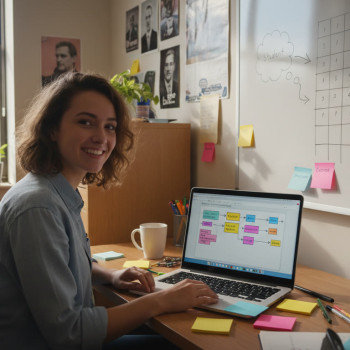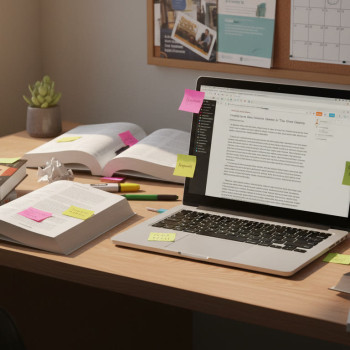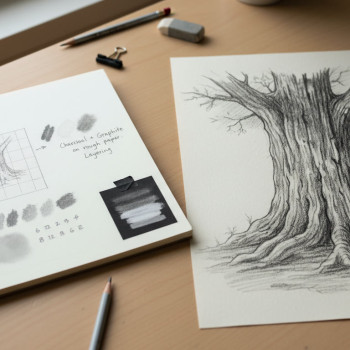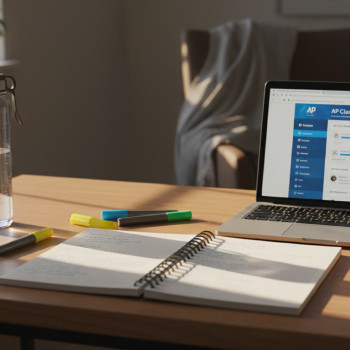Why Digital Minimalism Matters During AP Season
AP season is a sprint that feels like a marathon. You’re juggling course projects, late-night review sessions, and a calendar full of exams across May (and sometimes late-testing weeks). Add social apps, notification pings, and the avalanche of review videos, and it’s easy to confuse activity with progress. That’s where digital minimalism comes in: not banning technology, but choosing a focused, intentional relationship with it so your study time becomes real, deep, and effective.

What Is Digital Minimalism (In Plain Student Terms)
Digital minimalism is a mindset and a set of small choices: keep the tech that directly helps your goals and remove or re-route the rest. It’s not about being offline for the whole season; it’s about sculpting your attention so an hour of studying yields more than three distracted hours.
Practically, it means creating predictable study windows, curating your digital tools, and designing friction so impulse scrolling becomes an intentional break rather than an accident.
How Distraction Steals Your Study Time
It’s tempting to think we multitask well, but the brain pays a price each time you switch tasks. In the context of AP prep, those costs are very real: slower learning, less retention, and more exam-day anxiety because your practice lacked depth.
- Switch-costs: moving between tasks depletes attention and wastes time.
- Shallow work: scrolling and notifications promote surface-level review, not memorization or problem-solving.
- False productivity: a full checklist on your phone can feel like progress even if none of it is the hard practice that improves AP scores.
Real-World Example
Imagine two students preparing for AP Chemistry. Maya studies without interruptions for 90 minutes and completes three practice problems with full worked solutions; she tests herself afterward. Jamal studies off and on across a 3-hour window while switching between YouTube review videos and messaging—he watches more content but completes the same number of practice problems with less accurate explanations. On exam day, Maya recalls methods more quickly because her practice was deep and deliberate.
A Practical Digital Minimalism Plan for AP Students
This plan is designed for busy students. You don’t need to overhaul your life—just adopt a few repeatable routines you can stick with through the school year and exam weeks.
1. Do a 30-Minute Tech Audit
Spend half an hour listing all the apps, tabs, and notifications that interrupt you. Ask: which ones actively help my AP goals? Keep the rest behind deliberate barriers.
- Keep: AP Classroom, official practice materials, note-taking apps, a calculator app for math if needed.
- Shift: social apps into a folder called “Breaks” and set a schedule so they’re only available during true breaks.
- Remove: any app that repeatedly pulls you away from studying with little return.
2. Build a “Focus Schedule” Using Time Blocks
Use 50–90 minute deep-work blocks (experiment and find your sweet spot). Each block should have a single goal: solve five practice FRQs, drill multiple-choice timing, or review a single unit’s concepts until you can explain them aloud.
| Block Length | Purpose | Break |
|---|---|---|
| 50 minutes | Focused problem-solving or passage practice | 10 minutes (phone allowed) |
| 75 minutes | Deep concept mastery and mixed practice | 15 minutes (no phone—stretch, snack) |
| 25 minutes (Pomodoro) | Short drills or flashcard review | 5 minutes (skim social, then back to study) |
3. Create Digital Friction
Make distraction slightly harder to access: log out of social media, turn off nonessential notifications, or use a website blocker for your most dangerous sites during study blocks. The goal is not punishment—it’s to let your focus rise naturally.
4. Curate Your Study Tools
Quality over quantity. Instead of dozens of random review videos or practice sets, choose two reliable resources per subject and stick to them. For example:
- One comprehensive review source (notes or video series).
- One bank of timed practice questions or previous AP exams for mock testing.
When you limit your sources, you stop wasting time deciding what to use and spend more time learning.
Integrating Tech—When to Use It and When to Shut It Off
Technology can be a tremendous ally when used intentionally. Here are roles tech should play in your AP preparation and how to manage each.
Use Tech For:
- Timed practice exams and digital scoring simulation.
- Targeted concept videos after a practice session where you discovered a weakness.
- Digital flashcards for spaced repetition (use them briefly, not as background noise).
- Scheduling: calendar alerts for blocks, exam dates, and checkpoints.
Limit Tech For:
- Passive content consumption (binge-watching review videos without applying the knowledge).
- Multitasking between messaging and studying.
- Late-night scrolling that undermines sleep quality.
Designing Deep Practice Sessions
Deep practice is deliberate practice with feedback. For AP exams, this means active retrieval, timed conditions, and immediate correction.
Template for a 75-Minute Deep Session
- First 5 minutes: Set a clear goal and warm up (skim key formulas or vocabulary).
- Next 45 minutes: Complete practice problems under timed conditions.
- Next 15 minutes: Review answers, annotate errors, and correct misunderstandings.
- Final 10 minutes: Write a 2–3 sentence summary of what you learned and one question to ask your teacher or tutor.
This structure makes every minute accountable and creates a natural loop of practice, feedback, and reflection—exactly what raises AP scores.
Sleep, Nutrition, and Movement: The Underrated Study Tools
Digital minimalism frees up space for the physiological supports of learning. You will not remember dense AP material if your brain is tired, hungry, or sedentary.
- Sleep: aim for consistent bedtimes—quality sleep consolidates memory.
- Nutrition: avoid heavy sugar before study blocks; choose sustained energy (nuts, fruit, water).
- Movement: short walks between blocks reset attention and aid recall.
Quick Rituals to Anchor Your Day
Rituals reduce decision fatigue. Try a short pre-study routine: refill a water bottle, set a timer, and write the top goal for the session in one line. These small acts prime your brain for focus.
Using Practice Tests Effectively (Not Just Doing Them)
Full-length practice exams are invaluable—but only when analyzed properly. A smart post-test routine multiplies your learning.
- Score and categorize errors: content gap, careless mistake, or timing issue.
- Create a micro-action plan: 2–3 targeted study tasks to fix recurring errors.
- Simulate test conditions periodically (same start time, timed sections, minimal breaks).
Sample Tracking Table
| Test Date | Score | Top Error Type | Action Steps for Next Week |
|---|---|---|---|
| March 14 | 68% | Timing on MC | Do two timed MC sets per day; review pacing strategies |
| April 18 | 78% | Graph interpretation | Work 3 FRQs focused on graphs; annotate mistakes |
How to Use Breaks and Social Media as Rewards (Not Sabotage)
Don’t vilify leisure. Use it to recharge. The difference is structure: scheduled breaks are restorative; random scrolling is draining.
- Micro-breaks (5–15 minutes) after short blocks: walk, stretch, snack, check a message.
- Longer breaks (30–60 minutes) after 2–3 deep sessions: watch a short show episode, call a friend, or play a quick game.
- Digital Sabbath: pick one evening a week for low-screen activities—reading, cooking, or outdoor time—to reset your attention bank.
Personalized Help: When and Why to Ask for Support
There’s a tipping point where staying solo becomes inefficient. If you’re plateauing, feeling anxious, or missing targeted strategies, personalized guidance speeds progress. That’s where one-on-one tutoring is most useful: it diagnoses gaps, tailors study plans, and keeps accountability humane.
For students who benefit from a blend of human expertise and data-driven insight, Sparkl’s personalized tutoring offers tailored study plans, expert tutors, and AI-driven insights to highlight weak spots and measure progress. When integrated into a digital-minimalist routine, tutoring becomes a precision tool—not another distraction.
How to Make Tutoring Fit Your Minimalist Plan
- Schedule tutoring sessions immediately after a mock exam or a focused set of practice problems for maximum impact.
- Bring specific, prioritized questions to your tutor—what you learned from your post-test analysis.
- Use the tutor’s feedback to design the next week’s deep practice blocks.
Common Pitfalls and How to Avoid Them
Many students try digital minimalism and then fall back into old habits. Recognize these traps early:
- Perfectionism: expecting immediate perfection will burn you out. Start small with one focus block per day and build up.
- All-or-nothing: total offline weeks rarely stick. Choose controlled access instead.
- Overplanning without doing: schedules are useless if you don’t follow through. Aim for doable blocks, not perfect plans.
Two-Week Starter Plan (Easy to Adopt)
Use this starter plan to build momentum. It’s intentionally realistic so it fits around school and life.
| Week | Focus | Daily Goal |
|---|---|---|
| Week 1 | Establish structure | One 75-minute deep block + 30-minute review each school night |
| Week 2 | Increase quality | Two deep blocks on weekends; 50-minute block + practice test section on two weeknights |
Measuring Progress Without Obsession
Healthy measurement is about trends, not daily mood swings. Track: practice-test scores, error types, and how often you completed deep blocks. Celebrate small wins—consistency beats intensity in the long run.
Simple Weekly Metrics
- Number of deep blocks completed (goal: 6–10 per week).
- Practice questions completed and accuracy rate.
- Sleep consistency (bedtime within 60 minutes each night).
Final Notes: Making Minimalism a Habit, Not a Chore
Digital minimalism isn’t a punishment—it’s a toolkit that gives you more high-quality study time and less cognitive clutter. The techniques here are flexible: pick what fits your personality and schedule. If you prefer metrics, track your blocks and error correction. If you prefer human connection, set up regular check-ins with a teacher or a tutor.
And remember: the best AP prep balances discipline with kindness. You’re preparing for college-level work, but you’re also a student with a life. Intentional tech use helps you study smarter so you can sleep better, think clearer, and show up on exam day calm and ready.

Quick Checklist to Start Tomorrow
- Do a 30-minute tech audit tonight.
- Schedule one 75-minute deep block for tomorrow afternoon.
- Put your phone on Do Not Disturb for that block; use a physical timer.
- Plan one restorative activity for your weekly digital Sabbath.
- If you feel stuck, book a targeted session with a tutor and bring your post-test analysis—Sparkl’s personalized tutoring can help turn that analysis into a focused plan.
Parting Thought
AP season is a rare chance to practice disciplined, meaningful work. Digital minimalism is the frame that helps you do that without turning your life into a void of deprivation. It’s about saying yes to deep focus and no to the little things that chip away at your attention. Start small, be consistent, and use your tools—the human ones and the digital ones—with intention. You’ll not only prepare better for the AP exams, you’ll build study skills that last well beyond May.
























No Comments
Leave a comment Cancel